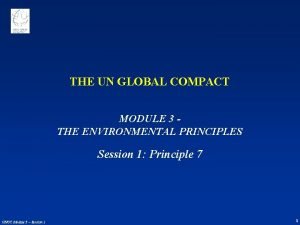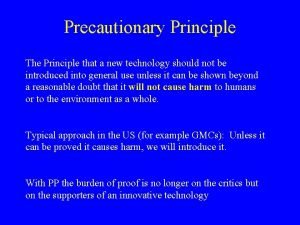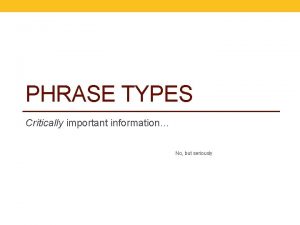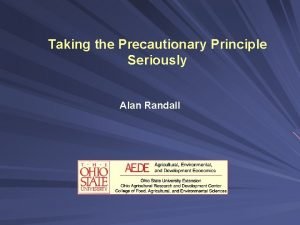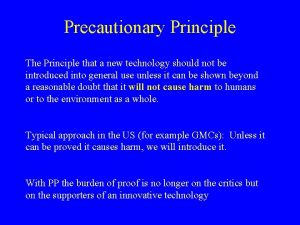Taking the Precautionary Principle Seriously Alan Randall Precautionary












- Slides: 12

Taking the Precautionary Principle Seriously Alan Randall

Precautionary Principle: when making multi-dimensional public decisions, acting to avoid and/or mitigate potential harmful consequences should be accorded high priority. We already have techniques for risk assessment and risk management Benefit cost, risk-benefit, expected value, expected utility Insurance, self-insurance, self-protection – private, public … Ordinary Risk Management … but the whole PP movement is founded on the claim that something more, something stronger than ORM, is needed. Examples from PP statements Uncertainty about harmful consequences does not justify failure to take precautionary action (Bergen Declaration 1990) Plausible but uncertain harm justifies precautionary intervention (UNESCO 2005) Uncertain harm requires intervention, and the burden of proof is shifted to the proponent of the proposed risky action (Wingspread Statement) Applications Multinational orgs – EU, UNESCO National laws – US endangered species laws. Regulatory policy – fisheries International agreements – Montreal protocol Trade disputes – hormones in beef, GMO commodities International food aid -- Zimbabwe

PP Controversies In lay discourse reactions range from … PP offers an idea that seems like ordinary commonsense: extraordinary risks call for extraordinary precaution … to PP would undermine business-as-usual and stifle innovation and growth. See, e. g. , the Proactionary Principle: People’s freedom to innovate technologically is valuable to humanity. The burden of proof therefore belongs to those who propose restrictive measures… Scholarly criticisms include: PP is meaningless (self-defeating) … would forbid any and all risky alternatives, yet even the no-action alternative involves risk (Sunstein). PP is nothing special – just good science, risk assessment, benefit cost analysis, i. e. , ORM (Farrow) The PP debate is just a quarrel about who owns the null hypothesis. There almost twenty different formulations of the PP in circulation, so how can it be taken seriously in real-world policy? The PP conflicts with other important values that good law and policy would surely respect, and it fails to provide clear instructions for resolving these conflicts.

My project To define and justify a PP that can be taken seriously. Neither foolish (not self-defeating, not readily invoked by false alarms) Nor redundant (nothing more than ORM) Must survive all of the criticisms above Getting started 1. Consider the Hippocratic Oath – above all, do no harm. What can this mean? If taken literally, many quite ordinary treatments would be forbidden Perhaps it means do no harm in the net (BC) Both action and no-action are risky (expected value or expected utility, ORM). Perhaps it calls for an asymmetric calculus Perhaps it is nothing more than an admonition to, before intervening, pause to consider the unintended consequences Implications Addresses case 1: a novel and potentially threatening action Identifies benefit cost, expected value, and expected utility approaches (ORM) Also, 2 approaches outside of the usual range of ORM – stronger: asymmetric treatment of uncertain but potential asymmetric harm; and weaker: sensitivity to possible unintended consequences

Getting started 2. Consider the rivet-popper (Erhlich and Ehlich 1981) “There is risk on both sides of the equation, and PP would paralyze innovation and stunt economic growth, all because we are scaredy-cats. ” But surely the risk to the plane is at least a candidate for classification as disproportionate and asymmetric relative to the risk to the economy. Implications Addresses case 2: a business-as-usual pattern of exploitation (or pollution) that might overstress natural and/or economic systems, potentially resulting in a novel and threatening outcome (regime shift) Frames the discussion in terms of collective threats (if the wings fail, all aboard the plane face extreme danger) asymmetric and disproportionate threat

Specifying the PP – an ETR framework If there is evidence stronger than E that an activity raises a threat more serious than T, we should invoke a remedy more potent than R T. Threats relevant to my PP: [Language notes: 1. harm, threat, risk. 2. risk, uncertainty, gross ignorance] disproportionate and asymmetric collective threats arise from complex and novel phenomena (things and events). Complexity possibility of regime shifts, tipping points Novelty on one side of the equation vs familiarity on the other Exacerbated by large spatial and/or temporal scale. PP offers guidance beyond the scope of ORM if the choice set includes some actions that induce disproportionate and asymmetric threats, and some actions that do not. [PP offers little beyond ORM in cases where all possible actions involve similar threats. ]

The nature of collective threats. The threats addressed by my PP are collective threats. Exposure is in considerable degree involuntary. The threat is to a larger system to which we are inextricably bound We are not sufficiently informed to exercise meaningful choice. Individual defaults may plausibly include possible outcomes of very large negative value – if I do not undergo the treatment I may die. For collective threats, the default is much more likely to be: if we do not take the proposed action, mortality may increase fractionally. Default threats to individuals may well be of greater relative magnitude than in the collective case Conversion of frequencies among populations to probabilities for individuals is less informative for individual choice than we might hope. An example may help. The PP seems not well-adapted to guide decisions re the permissibility of clinical trials. Peterson (2006, 2007) has argued that the case of clinical trials is informative to the PP debate: “… directly applicable to recent discussions of PP in medicine, biotechnology, environmental management, and related fields”. I think not – my PP would not apply to the clinical trials case (the threat is not asymmetric), but collective threats are different and the PP is much better adapted to them.

R. Remedies may include Prohibit the intervention / halt the business-as-usual stress Avoidance, mitigation, and/or adaptation – beyond those that may be recommended by BC or ORM considerations Insurance, self-insurance, and self-protection – it takes a PP to justify a package that includes ORM and some additional restraints. There are two additional components of a comprehensive precautionary policy Monitor, study, and reassess the threat reduce or mitigate disproportionate negative impacts E. What evidence would invoke PP? … plausible and credible scientific evidence Commonsense notions of scientific plausibility and credibility. US court decisions: Daubert, Kimho Tire, Cellular Telephone. Judgments of scientific credibility are the province of scientists, not ordinary people. [See also Kahan et al response to Sunstein] Campaign to politicize science and reduce scientific discourse to an ordinary cultural quarrel: “junk science” (junkscience. com), “muddying the waters” (Michaels and Monforton), “manufactured uncertainty”, “false balance”, and “teaching the controversy”. But … [a post-postmodernist defense of science as an institution capable of resisting and surviving these challenges].

Tentative working definition of the precautionary principle In response to a scientifically credible threat of disproportionate and asymmetric harm, we should take avoidance and mitigation measures beyond those justified by expected welfare considerations. On the possibility of a utilitarian PP. Can we imagine a utilitarian PP (utilitarian ORM might logically include PPs that were consistently utilitarian)? Early attempts at a utilitarian PP were problematic because extreme risk aversion was imposed in one guise or another, and often unconvincingly. See also Peterson’s (2006) claim that the PP is incoherent. Randall (e. g. , 2007)argued that all of this (over)reaching for a utilitarian PP is much too strained – there is no convincing argument against the idea that the scope for business-asusual utilitarian ethics might coherently be bounded by non-utilitarian constraints. Margolis and Naevdal (2008) argued that thresholds, kinks, etc. that might generate a utilitarian PP might be found in the response function rather than the utility function. In the end the arguments of Margolis and Naevdal (who have justified a utilitarian PP for certain particular specifications of how the world works), and Randall (who argues that a coherent precautionary constraint on the domain of utilitarian ethics does not itself have to be utilitarian) can coexist and in fact complement each other. Peterson’s (2006) case that the PP is incoherent falls when faced with systemic complexity in a utilitarian universe, and when faced with ethical pluralism.

Understanding the PP as a principle Discussion of PP commonly proceeds in legalistic terms, seeks enforceable interpretations exhibits discomfort with competing definitions, and inconsistencies (either internal or with other widely-honored values). See also Peterson 2007: PP cannot guide action and decision unless it is structured and used as a stand-alone rule. However, this discussion reflects a rather odd view of what can reasonably be expected of a principle Principles are general statements of normative moral positions for a class of concerns. Some principles are recognized by many competing moral systems. To call a moral statement a principle does not grant it lexical priority over other principles – clashes between principles are resolved by weighing the principles and the facts of the case. Yet, a principle is much more than a preference – we feel a serious moral loss when we have to compromise a principle in a particular case. Agreed principles provide not policies but a frame for policy resolution that anticipates and accounts for competing and conflicting principles. If PP is viewed as a principle, then it succeeds if it serves as a principle that guides law and policy, in the sense that it embodies a considerable moral intuition to be consulted along with other pertinent principles and values when the issues it addresses come into play.

The PP and governance Pragmatic policy processes submerge value discourse – “fact-based” policy: no value matters until it matters a special challenge when dealing with obligations to the future Acting on principles in practical governance The fundamental framework proposed and defended here would make business-as-usual decisions according to familiar welfare criteria, while providing precautionary exceptions for particular threats that are scientifically credible, disproportionate, and asymmetric. The precautionary exceptions are justified by principles that would be honored by many different moral systems: Do not sell-out something unique and valuable for modest gain Do not take inordinate risks for modest gain Do not impose big risks on the public for modest private gain Do not impose big risks on the future for modest immediate gain. This framework would respect both the modern experience of technical progress and increasing welfare, and the reasonable instinct for caution as we continue to push at the frontiers of what can be known about our planet’s capacity to support future welfare.

What can we reasonably ask government to do, in an era when government seems afraid of governing? Do more to get Ordinary Risk Management right Benefit cost, risk-benefit, expected value, expected utility Insurance, self-insurance, self-protection – private, public Articulate clear principles and take them seriously in practice Commitment to precautionary exceptions in cases that exceed a threshold of concern Commitment to transparent and inclusive public decision processes Commitment to equitable sharing of burdens – esp. burdens undertaken to benefit future generations Bind managers to principles, but encourage them to interpret principles in practice via a serious policy dialogue Neither planning to the 4 th decimal place, nor abdication to stakeholder conventions
 Taking curriculum seriously
Taking curriculum seriously Taking curriculum seriously
Taking curriculum seriously Precautionary principle
Precautionary principle Examples of environmental health
Examples of environmental health Example of biological hazard
Example of biological hazard Precautionary principle
Precautionary principle Precautionary principle in environmental law
Precautionary principle in environmental law Precautionary principle
Precautionary principle Precautionary principle
Precautionary principle Life is too important to be taken seriously
Life is too important to be taken seriously Seriously cinema
Seriously cinema Gerunds and participles
Gerunds and participles Whmis acronym
Whmis acronym





